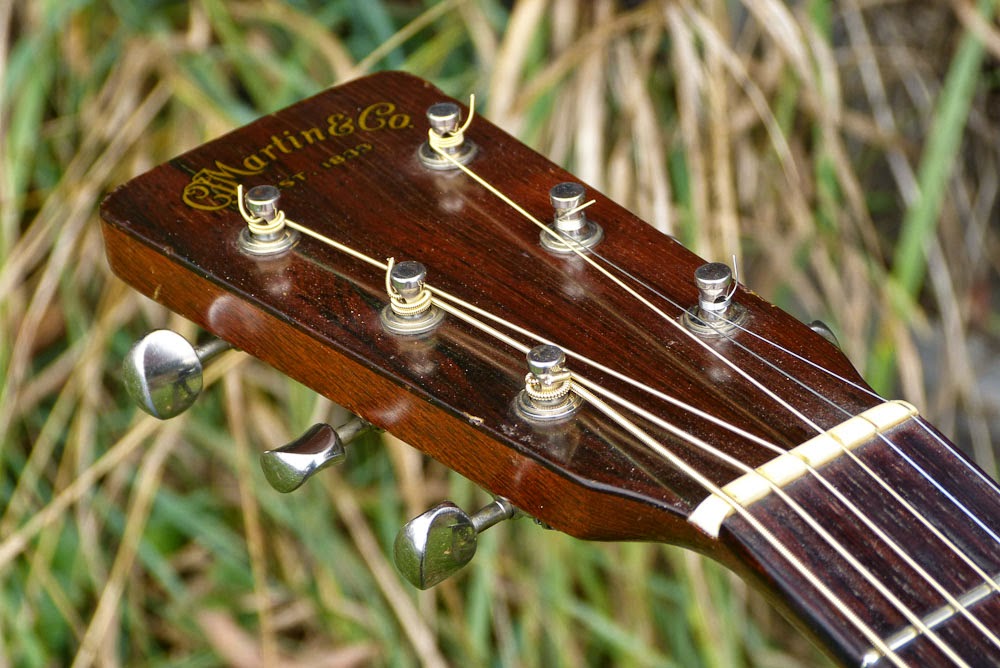1950 Martin 0-18 Flattop Guitar
Ever since owning a nice '54 0-15 for a while I've personally been hooked on the small-body Martin 14-fret sound. This one has it in spades. It's that warm but focused, slightly driven, but clear sound that you get when going at these with a good-sized flatpick that does it for me. Other folks will love the super fingerpicking qualities and fret access over a 12-fret... but I just love the sound of dug-in and crosspicked flatpicking on these guys. It's easy to hold the rhythm line with the clean midrange you get on this body size.
This one came via a customer/consignor and required a simple fret level/dress and a little bridge work to get it going. It's mostly crack-free (a couple of bend-area small hairlines on the sides) and is in well-played but good shape. The setup is spot on (3/32" bass and 1/16" treble fret top to string bottom at the 12th fret) with a regular set of 12s on it.
Mm, hmm... it's a pretty guitar. Like all style 18 models, the back, sides and neck are solid mahogany while the top is solid spruce. Judging from the timeframe: probably sitka spruce.
This has the original nut and tuners all accounted-for. Nut width is 1 11/16" as per the general specs of the instrument would imply.
The frets are in good shape and set in a radiused, rosewood board. The neck profile is nice and easy with a C shape that's a "hair V." You know... the Martin shape! It feels approximately the same as modern vintage-spec Martin models but perhaps ever so slightly thicker front to back as you get to the heel.
You can see the various pickwear across the face of the guitar. Evidently someone liked to strum energetically...! Still, the top is in good shape.
What strikes you when you hold a nice old Martin is just how well-built they are. Everything is cut "just so" and tidied-up to very close specs in production... even on a model like this which was only really a couple rungs up on their price list at the time.
This original bridge had a bit of light sanding (on top) and light chip-outs/tiny hairline cracks on its front edge when it came in. I carefully removed the original (glued-in) saddle and then ever so slightly reprofiled (to remove chip-outs) from where it was to begin with. This took about 1/32" of material off of the front end which is also about how far I reduced the action height at the bridge. I left the saddle at the size I found it but did bring the slot down to lower action (it's peeking out over the wood as much as it was when it came in). After that I cleaned up the string ramps (which were really just worn-in ramps) and buffed it up.
My only complaint with Martin belly bridges from this period are their tendency to let longer string-end wrappings ride up to or over the saddle. This is because they put the pins so close to the rear of the saddle that it's almost inevitable as the bridge plate wears even slightly. Right now the bass string-end wrappings are riding over the saddle. Soundwise... I think you can hear in the soundclip above that it doesn't matter. There are two ways to go about changing this, however -- choice (A) is to add extra ball-ends to the ball-ends and choice (B) is to add a tiny bridge plate cap. Well, I guess there's choice (C) as well which is to fill in the bridge pin holes and then ream them out again to see if that helps, too, before plate-capping it.
There's, for sure, some use-wear to the top but that's "all charm" to me. I can't stand picking up a guitar that I'm afraid to play because the finish is immaculate. It just makes me feel nervous.
Can't argue with cool old Klusons!
Also, just a note on hardware: everything is original save newer bridge pins and a new endpin.
The tortoise binding mixes nicely with the 'hog back and sides.
Oops, a little out of focus... but just below the waist on either side there are tiny hairline cracks. This one I've drop-filled and clamped (good to go) just to make sure but the ones on the other side were so small and tight that there's no reason to address them. I'm guessing that they're just old dryness cracks.
Endstrip!
I figured I'd better get a nicer pic of the headstock with that pretty Brazilian glowing on it.
It comes with an old Geib 00-size chip case. Is it original? Possibly.
Here are the tiny hairlines opposite the other side. You can also see that pretty tortoise binding coloration in the sunlight here as well.






















Comments